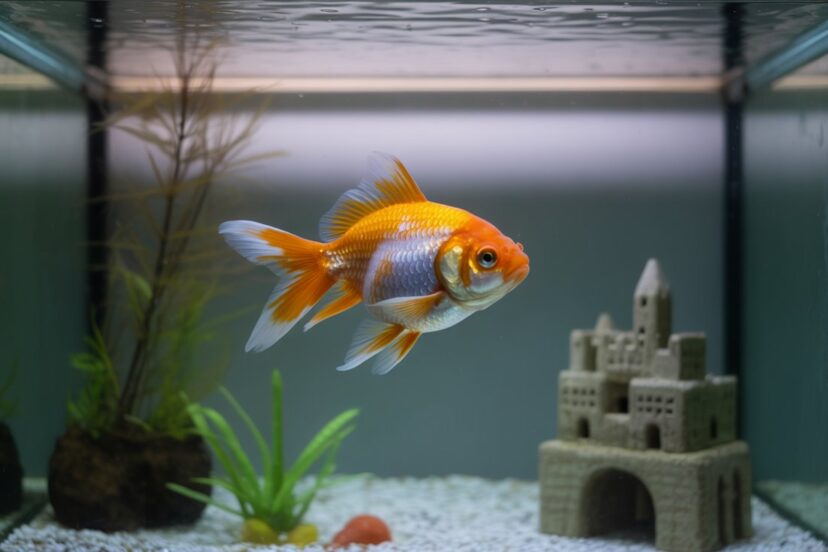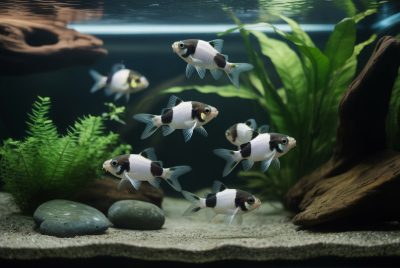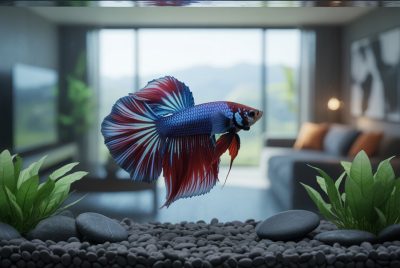10 Common Signs of Fish Stress
*We may earn a commission for purchases made using our links. Please see our disclosure to learn more.
The gentle hum of an aquarium filter creates a peaceful ambiance, but beneath the surface, your fish might be sending distress signals that go unnoticed. Fish stress is more common than most aquarium owners realize, yet it’s one of the most preventable causes of fish illness and death. Understanding these warning signs of fish stress isn’t just about maintaining a beautiful tank—it’s about ensuring the wellbeing of living creatures that depend entirely on their caretaker’s knowledge and attention.
“Fish stress is often the silent precursor to disease and death in aquariums. Recognizing early warning signs can mean the difference between a thriving ecosystem and a tank full of suffering creatures.”
– Marine Biology Research Institute
Key Takeaways
- Early Detection Saves Lives: Recognizing stress symptoms early prevents serious health complications and death
- Environment Matters Most: Poor water quality, overcrowding, and inadequate habitat setup are primary stress causes
- Behavioral Changes Come First: Fish typically show behavioral symptoms before physical ones
- Prevention is Key: Maintaining proper water parameters and tank conditions prevents most stress-related issues
- Quick Action Required: Once stress signs appear, immediate intervention is crucial for fish survival
Understanding Fish Stress: The Hidden Crisis
Fish stress manifests in ways that mirror human anxiety responses—through behavioral changes, physical symptoms, and weakened immune function. Unlike terrestrial pets, fish cannot vocalize their distress, making observation the primary tool for detecting problems. The aquatic environment amplifies stress factors because fish cannot escape their surroundings when conditions become unfavorable.
1. Rapid or Labored Breathing
One of the most immediate signs of fish stress appears in their respiratory patterns. Healthy fish maintain steady, rhythmic gill movements, but stressed fish often exhibit rapid, shallow breathing or appear to gasp at the surface. This symptom typically indicates oxygen deficiency, poor water quality, or temperature fluctuations.
What to Look For:
- Excessive gill movement
- Fish spending time at the water surface
- Mouth opening and closing rapidly
- Pale or darkened gills
Immediate Actions: Check oxygen levels, test water parameters, and ensure proper filtration. Increase surface agitation to improve oxygen exchange if necessary.
2. Loss of Appetite and Feeding Changes
A stressed fish’s relationship with food changes dramatically. Previously eager eaters may ignore their favorite treats, while others might become food aggressive or exhibit unusual feeding behaviors. This symptom often precedes more serious health issues.
Warning Signs Include:
- Complete refusal to eat
- Spitting out food after taking it
- Aggressive competition for food
- Eating significantly less than usual
Underlying Causes: Poor water quality, overcrowding, illness, or recent tank changes can trigger appetite loss. The digestive system often shuts down when fish feel threatened or uncomfortable.
3. Abnormal Swimming Patterns
Fish develop specific swimming habits based on their species and personality. Dramatic changes in these patterns signal distress. Stressed fish might swim erratically, lose coordination, or exhibit behaviors completely outside their normal range.
Observable Behaviors:
- Swimming in tight circles
- Sudden darting movements
- Floating at odd angles
- Staying motionless for extended periods
- Swimming against glass repeatedly
These behaviors often indicate neurological stress, territorial disputes, or environmental dissatisfaction.
4. Color Changes and Fading
Vibrant fish colors serve multiple purposes in nature—from attracting mates to warning predators. Stress directly impacts a fish’s ability to maintain these colors, leading to fading, darkening, or unusual color patches.
Visual Indicators:
- Overall color dulling
- Dark stress stripes appearing
- Unusual pale or white patches
- Colors becoming more intense (sometimes indicating aggression)
The Science Behind Color Changes: Chromatophores, specialized cells containing pigments, respond to stress hormones. When fish feel threatened or uncomfortable, these cells contract or expand, altering the fish’s appearance.
5. Hiding and Withdrawal Behaviors
While some fish naturally prefer secluded areas, sudden increases in hiding behavior often indicate stress. Fish may wedge themselves into tight spaces, refuse to leave decorations, or show increased skittishness around tank activities.
Concerning Patterns:
- Previously social fish becoming reclusive
- Refusing to come out during feeding time
- Excessive hiding during daylight hours
- Cowering in corners or behind equipment
This behavior typically stems from feeling threatened by tank mates, environmental changes, or inadequate shelter options.
6. Aggressive or Territorial Displays
Stress can manifest as increased aggression, even in typically peaceful species. Fish might chase tank mates excessively, guard food or territory aggressively, or display threatening postures toward other fish or their own reflection.
Aggressive Indicators:
- Fin nipping or actual attacks on other fish
- Chasing behavior that doesn’t stop
- Protecting specific areas of the tank
- Flaring gills or spreading fins in threat displays
Root Causes: Overcrowding, inadequate territory, mating frustrations, or resource competition often trigger aggressive responses in stressed fish.
7. Physical Symptoms and Body Language
Stressed fish develop physical symptoms that become more apparent as their condition worsens. These signs of fish stress often indicate that stress has progressed to a point where immediate intervention is crucial.
Physical Warning Signs:
- Clamped fins held close to the body
- Torn or frayed fin edges
- White spots or patches on skin
- Bulging or sunken eyes
- Listless body posture
The Progression of Physical Stress: Initial stress weakens the immune system, making fish susceptible to bacterial, fungal, and parasitic infections. What begins as environmental stress can quickly become a medical emergency.
8. Gasping at the Surface
Surface gasping represents one of the most critical stress symptoms, often indicating severe oxygen deprivation or gill damage. Fish engaging in this behavior require immediate attention to prevent suffocation.
Emergency Indicators:
- Constant positioning at water surface
- Mouth opening and closing at surface level
- Inability to swim normally underwater
- Other fish exhibiting similar behavior
Immediate Response Required: This symptom demands quick action—increase water circulation, check filtration systems, test for toxic substances, and consider emergency water changes.
9. Scratching and Rubbing Behaviors
Fish scratching against decorations, gravel, or tank walls indicates irritation that could stem from parasites, poor water quality, or chemical burns. This behavior, called “flashing,” often precedes visible physical symptoms.
Scratching Behaviors:
- Rubbing against rough surfaces
- Quick darting movements followed by contact with objects
- Repetitive scratching in the same areas
- Multiple fish showing similar behaviors
Potential Causes: External parasites, ammonia burns, chlorine exposure, or pH fluctuations commonly cause skin irritation leading to scratching behaviors.
10. Lethargy and Reduced Activity
Active fish species that suddenly become lethargic show clear signs of stress or illness. This symptom often appears alongside other warning signs and indicates that the fish’s energy reserves are being depleted by stress responses.
Lethargy Symptoms:
- Resting on the bottom for extended periods
- Slow, labored swimming motions
- Lack of interest in surroundings
- Delayed responses to stimuli
Environmental Factors Contributing to Fish Stress
Understanding stress causes helps prevent problems before they develop. Most fish stress stems from environmental factors within the aquarium owner’s control.
Water Quality Issues
Poor water quality ranks as the primary cause of fish stress. Ammonia, nitrite, and nitrate buildups create toxic conditions that force fish into survival mode. Regular water testing and maintenance prevent these issues.
Critical Parameters to Monitor:
- Ammonia levels (should be 0 ppm)
- Nitrite levels (should be 0 ppm)
- Nitrate levels (should be under 20 ppm)
- pH stability within species requirements
- Temperature consistency
Overcrowding and Territory Disputes
Overstocked tanks create chronic stress conditions as fish compete for space, food, and territory. Each species requires specific space allocations, and exceeding these limits leads to aggression, poor water quality, and stress-related illnesses.
Inadequate Habitat Setup
Fish require environments that meet their natural behavioral needs. Insufficient hiding places, inappropriate lighting, wrong substrate types, or lack of swimming space create ongoing stress that weakens fish over time.
Prevention Strategies for Fish Stress
Preventing fish stress requires proactive aquarium management and understanding of fish behavior patterns. Most stress-related problems can be avoided through proper planning and consistent care.
Establishing Proper Tank Conditions
Creating an appropriate environment from the beginning prevents most stress issues. Research species requirements thoroughly before adding fish to ensure compatibility with tank conditions and other inhabitants.
Regular Maintenance Routines
Consistent water changes, filter cleaning, and parameter testing maintain stable conditions that keep fish comfortable. Establish a maintenance schedule and stick to it religiously.
Quarantine Procedures
New fish should be quarantined for 2-4 weeks before introduction to the main tank. This practice prevents disease transmission and allows new fish to acclimate without the stress of established tank hierarchies.
When to Seek Professional Help
Some situations require expert intervention to save stressed fish. Recognize when home remedies aren’t sufficient and professional guidance becomes necessary.
Situations Requiring Expert Help:
- Multiple fish showing severe symptoms simultaneously
- Symptoms persisting despite corrective measures
- Unusual disease symptoms or rapid deterioration
- Complex water chemistry issues
Building a Stress-Free Aquarium Environment
Creating an environment that minimizes stress requires attention to both physical and social factors within the aquarium ecosystem.
Species Compatibility
Choosing compatible fish species prevents territorial disputes and reduces competition stress. Research adult sizes, temperaments, and environmental needs before making purchasing decisions.
Feeding Strategies
Proper feeding schedules and techniques reduce food competition stress. Feed small amounts multiple times daily rather than large portions once daily, and ensure all fish receive adequate nutrition.
Environmental Enrichment
Provide appropriate decorations, plants, and hiding spots that allow fish to express natural behaviors. Different species require different types of enrichment to feel secure and comfortable.
The Long-Term Impact of Fish Stress
Chronic stress in fish leads to compromised immune systems, shortened lifespans, and reduced quality of life. Understanding these consequences emphasizes the importance of stress prevention and early intervention.
Fish experiencing ongoing stress become susceptible to diseases that healthy fish easily resist. The stress response diverts energy from growth, reproduction, and immune function toward survival mechanisms, creating a cycle of declining health.
Conclusion
Recognizing and addressing fish stress requires careful observation, environmental knowledge, and commitment to proper aquarium maintenance. The ten signs outlined here serve as early warning systems that, when heeded, can prevent serious health complications and ensure fish live healthy, comfortable lives.
Fish stress is largely preventable through proper tank setup, regular maintenance, and understanding of species-specific needs. By creating stable, appropriate environments and monitoring fish behavior closely, aquarium owners can provide their aquatic pets with the quality of life they deserve.
The responsibility of fish ownership extends beyond providing food and shelter—it includes understanding the subtle communications fish use to express their needs and discomforts. Armed with this knowledge, aquarium enthusiasts can create thriving aquatic ecosystems where fish display their natural behaviors and vibrant health.
Remember that fish depend entirely on their caretakers for survival. Taking the time to learn these stress signals and respond appropriately transforms aquarium keeping from a hobby into a meaningful practice of animal husbandry and environmental stewardship.
Frequently Asked Questions
Q1: How quickly can fish stress lead to death?
Fish stress can progress to fatal conditions within 24-48 hours in severe cases, particularly when involving oxygen deprivation or toxic water conditions. However, chronic stress typically weakens fish over weeks or months, making them susceptible to diseases that eventually prove fatal. Early intervention significantly improves survival chances.
Yes, fish can fully recover from stress when underlying causes are identified and corrected promptly. Recovery time varies depending on the severity of stress and the fish’s overall health, typically ranging from a few days to several weeks. Providing optimal water conditions and reducing stressors accelerates the healing process.
Q3: Do different fish species show stress differently?
Absolutely. Each species has unique stress responses based on their natural behaviors and physiology. For example, schooling fish may become isolated when stressed, while territorial species might become more aggressive. Understanding species-specific behaviors helps identify stress symptoms more accurately.
Q4: Is it normal for new fish to show stress signs initially?
Yes, newly introduced fish commonly exhibit stress symptoms during the acclimation period, which can last 1-2 weeks. However, symptoms should gradually improve as fish adjust to their new environment. Persistent or worsening symptoms indicate underlying problems requiring attention.
Q5: Can fish stress affect other tank inhabitants?
Fish stress is often contagious within aquarium environments. Stressed fish may spread diseases, disrupt social hierarchies, or indicate environmental problems affecting all tank inhabitants. Additionally, aggressive stress responses can directly harm other fish through attacks or territorial disputes, making early intervention crucial for overall tank health.




